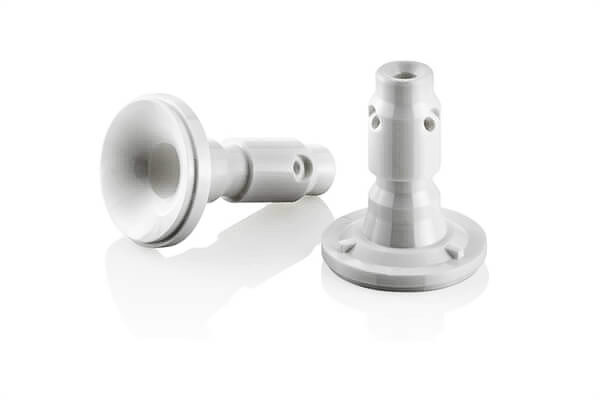Precision and Biocompatibility: Alumina Ceramic Injection Molding in Medical Devices
Introduction
The medical device industry demands materials with exceptional precision, reliability, and biocompatibility to ensure patient safety and performance. Among advanced biomaterials, Alumina (Al₂O₃) ceramics stand out for their outstanding biocompatibility, mechanical strength, and chemical inertness, ideal for producing precise and durable medical components.
Ceramic Injection Molding (CIM) is a specialized manufacturing process that effectively addresses the stringent requirements of medical devices. By combining alumina’s remarkable material properties with the precision of injection molding technology, CIM enables the cost-effective production of complex, high-quality medical ceramic parts.
Understanding Alumina Ceramic Injection Molding (CIM)
Ceramic Injection Molding is a sophisticated manufacturing method designed to produce intricate ceramic parts with exceptional dimensional accuracy and repeatability. The CIM process begins by blending fine alumina ceramic powder with thermoplastic binders, forming a consistent, injection-moldable feedstock.
This feedstock is then injected into precision molds under high pressure (typically 50–200 MPa), heated to approximately 130–180°C. The molded components precisely replicate complex geometries, achieving dimensional tolerances as tight as ±0.02 mm—essential for high-precision medical applications.
Post-injection molding, the alumina components undergo a critical debinding process to remove thermoplastic binders without affecting structural integrity. This usually involves thermal debinding (temperatures around 200–600°C) or solvent-based methods. Subsequently, the parts are sintered at high temperatures (1600–1800°C), achieving 98–99.5% theoretical maximum densities, resulting in robust, high-strength medical-grade ceramics.
Key Properties of Alumina Ceramics in Medical Devices
Alumina ceramics offer several properties uniquely beneficial for medical device applications:
Superior Biocompatibility: Alumina is chemically inert and exhibits outstanding biocompatibility, minimizing inflammatory reactions, tissue irritation, and implant rejection.
Excellent Mechanical Strength: Alumina ceramics offer impressive mechanical strength (flexural strength often exceeding 350 MPa), suitable for load-bearing medical implants and surgical instruments.
Wear Resistance: With exceptional hardness (9 Mohs), alumina ceramics resist wear, abrasion, and surface degradation, significantly extending the lifespan of medical implants.
Chemical Stability and Corrosion Resistance: Alumina ceramics are highly resistant to chemical degradation, ensuring durability even in harsh physiological environments, crucial for long-term implantation.
These combined attributes make alumina ceramics highly suitable for precision medical components, from orthopedic implants to dental devices.
Alumina Ceramic Injection Molding Applications in Medical Devices
The precision, reliability, and biocompatibility offered by CIM-produced alumina ceramics benefit numerous medical device applications, including:
Orthopedic Implants and Joint Replacements
CIM alumina ceramics are extensively utilized in orthopedic implants, such as femoral heads and acetabular cups in hip replacements. Their superior wear resistance significantly reduces particulate debris generation, enhancing implant longevity and patient comfort.
Dental Implants and Prosthetics
Alumina ceramics produced via CIM provide excellent biocompatibility and aesthetic properties, ideal for dental implants, crowns, and orthodontic brackets. Their resistance to chemical corrosion ensures long-term stability and improved oral health outcomes.
Surgical Instruments and Tooling
High-precision alumina ceramic surgical instruments, such as scalpel blades, cutting tools, and endoscopic components, benefit from CIM’s exceptional dimensional control and ceramic hardness, ensuring superior cutting performance, durability, and ease of sterilization.
Cardiovascular Components
Alumina ceramics offer electrical insulation and dimensional precision crucial for cardiovascular applications, such as ceramic feed-throughs, pacemaker insulators, and structural components within cardiac assist devices. Their chemical stability ensures patient safety and device reliability over extended periods.
Advantages of Alumina Ceramic Injection Molding in Medical Devices
Alumina ceramic components produced via CIM deliver substantial advantages in medical device manufacturing:
Precision and Dimensional Accuracy: CIM consistently achieves high dimensional precision (±0.02 mm), enablingthe production of intricate, miniaturized medical components.
Superior Biocompatibility: Alumina ceramic’s inherent biocompatibility reduces risks associated with implant rejection, allergic reactions, or inflammation, significantly enhancing patient safety and comfort.
High Strength and Durability: Alumina’s mechanical robustness and wear resistance ensure that medical implants and tools exhibit prolonged operational life, reducing patient revision surgeries and healthcare costs.
Cost Efficiency and Scalability: CIM provides economical mass production of intricate ceramic components, significantly reducing manufacturing costs compared to traditional ceramic machining, especially in high-volume scenarios.
Considerations for Effective Alumina CIM in Medical Applications
Successfully integrating alumina CIM into medical device production requires careful consideration of several critical factors:
Material Purity and Feedstock Consistency: Ensuring consistent alumina powder purity (>99.5%) and precise feedstock formulation is critical to achieving desired biocompatibility, mechanical properties, and part precision.
Precision Mold Design: Mold design must ensure superior dimensional accuracy and surface finish while withstanding repeated high-pressure molding cycles without degradation.
Controlled Debinding and Sintering: Accurate control of debinding parameters (temperature, duration) and sintering conditions (atmosphere, uniform heat distribution) is crucial for defect-free, high-density alumina ceramic parts suitable for sensitive medical applications.
Regulatory Compliance: Alumina ceramic parts for medical applications must adhere strictly to medical device standards and regulatory approvals (such as FDA and ISO 13485), necessitating rigorous quality control and validation protocols throughout the production cycle.
Future Trends in Alumina CIM for Medical Devices
The future of alumina ceramic injection molding in the medical device sector is promising, driven by continuous innovations in materials science, molding technologies, and biomedical engineering. Increased adoption is anticipated in minimally invasive surgical devices, micro-scale implants, and next-generation personalized medicine solutions, leveraging CIM’s precision and biocompatibility advantages.
Conclusion
Alumina ceramic injection molding offers exceptional potential for advancing medical device capabilities, precision, and patient outcomes. Its superior biocompatibility, dimensional precision, mechanical strength, and manufacturing efficiency position CIM-produced alumina ceramics as essential materials for innovative, reliable, and cost-effective medical devices.
FAQs
Why is alumina ceramic injection molding ideal for medical devices?
Which medical device components are commonly produced using alumina CIM technology?
How does ceramic injection molding improve the biocompatibility of medical implants?
What are critical manufacturing considerations for successful alumina CIM in medical applications?
Can alumina ceramic injection molding components meet rigorous medical regulatory standards?

